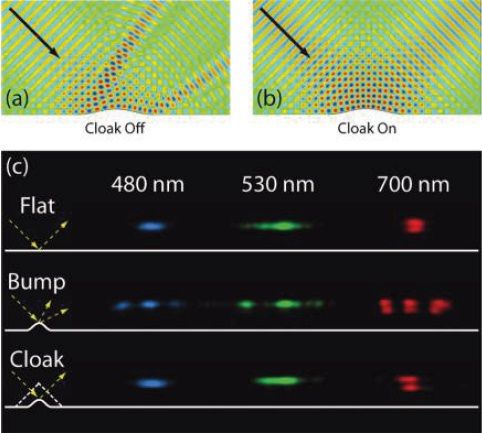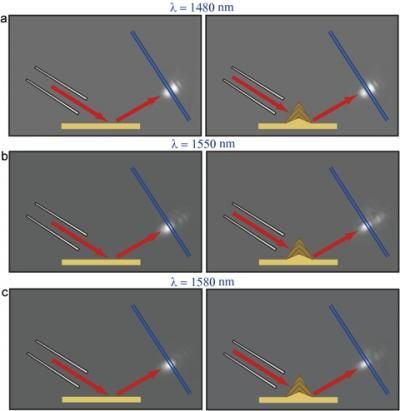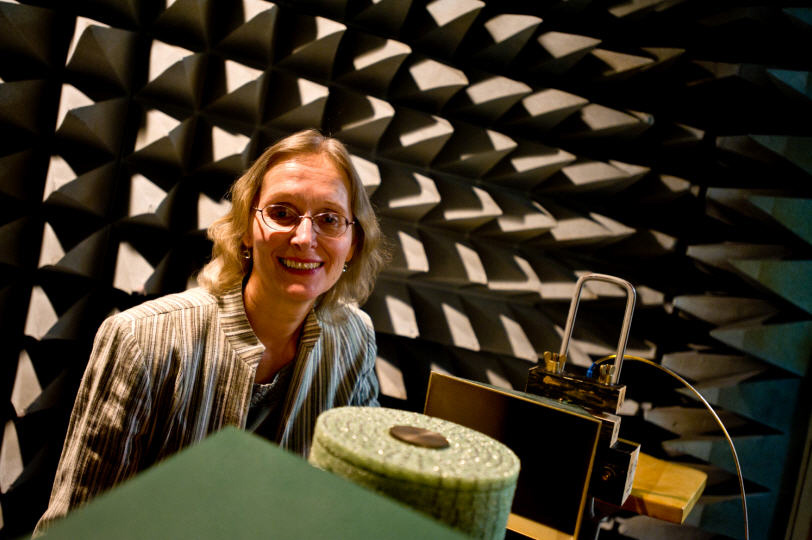Miranda Marquit
PhysOrgFri, 13 Mar 2009 00:00 UTC
"Many groups have been working devices that make objects invisible," Che Ting Chan tells PhysOrg.com. "Most of these devices, however, encompass the object to be cloaked." Chan, a scientist at The Hong Kong University of Science and Technology, believes that it is possible to create a cloaking device that would be able to render an object invisible without encompassing it.
"With the devices that encompass the object," Chan continues, "the cloaked subject is 'blind'. It can't 'see' out through the cloak. We can't see the object, but the object can't see us, either. We wanted to create a conceptual design that would let the object 'see' out through the cloak while hiding it from sight." Along with Yun Lai, Huanyang Chen and Zhao-Qing Zhang, Chan believes that this could be accomplished. Their ideas are published in Physical Review Letters: "Complementary Media Invisibility Cloak that Cloaks Objects at a Distance Outside the Cloaking Shell."
Right now, such a device exists only theory. "We haven't built the device," Chan says, "but we have shown mathematically how it could work. It is a very specific description of the materials needed. If you have the time and resources, we think it could be done." He points out that it might have interesting possibilities in a number of fields where invisibility might be desirable.
Shuang Zhang
2PhysicsSun, 13 Feb 2011 08:29 UTC
Making things invisible is certainly appealing to most people - including scientists and magicians. Invisibility cloaks have existed only in movies and science fictions until 2006 when Pendry and Leonhardt independently pointed out ways to scientifically realize them [1, 2]. Transformation optics, the enabling theoretical tool to make this happen, works by optically compressing a spatial region to leave out a niche that cannot be accessed by light, while keeping its outer boundary intact so nothing seems to have happened when light exits the cloak.
This new research field has witnessed rapid progresses. Soon after the theoretical proposal, the first experimental demonstration of invisibility was shown at microwave frequencies in 2007 [3], and within 2 years, invisibility has reached Near-Infrared, the frequencies normally used for optical communications [4, 5]. These milestone works show that invisibility has become more a reality than fiction. However, all those invisibility cloaks were made from artificially engineered structures with subwavelength feature size, the so called metamaterials. At optical frequencies, the nano- and micro- fabrication of metamaterials limited the achievable invisibility cloak to a few wavelengths.
Recently two independent teams (including us at University of Birmingham, Imperial College London and Technical University of Denmark) have succeeded in scaling up the invisibility cloak to hide things of macroscopic scale [6, 7]. While previous works on optical invisibility have focused on non-uniform isotropic artificial media, we utilize uniform, anisotropic medium to construct the invisibility cloak. Specifically, our invisibility cloak was made from natural birefringent crystals, and therefore they can be easily scaled up to hide things at least thousands of times bigger than optical wavelengths. In addition, the cloaks work in the visible range, therefore the cloaking effect can directly be seen with our naked eyes.
Physicists from the University of Birmingham, with colleagues at Imperial College, London, and Technical University of Denmark, have demonstrated an 'invisibility cloak' that can hide a three-dimensional object, centimetres in dimension, large enough for the cloaking area to be visible to the human eye, according to research published today in the journal Nature Communications.
The scientists have shown that they are able to hide an object that is much bigger than those cloaked by other research groups. Previous studies have demonstrated cloaking by using a metamaterial - a fabricated composite with optical properties not found in nature - which limits the size of the cloaking region, while the team from UK and Denmark have used a natural crystal called calcite, which has enabled them to hide a larger object.
Calcite is a transparent mineral with birefringent or double-refraction properties, which means that light enters the calcite and splits into two rays of different polarizations travelling at different speeds and in different directions.
The team has been able to cloak larger objects because it has employed a cloaking design that did not require inhomogeneous material properties, as all the previous works did. This demonstration was performed, both in the air and in a container of liquid, by using two triangular pieces of calcite glued together, placed on a mirror. The size of the cloaking area is not limited by the technology available, only by the size of the calcite crystal.
An undergraduate student has overcome a major hurdle in the development of invisibility cloaks by adding an optical device into their design that not only remains invisible itself, but also has the ability to slow down light.
The optical device, known as an 'invisible sphere', would slow down all of the light that approaches a potential cloak, meaning that the light rays would not need to be accelerated around the cloaked objects at great speeds ― a requirement that has limited invisibility cloaks to work only in a specified region of the visible spectrum.
This new research, published today, Tuesday 9 August, in the Institute of Physics and German Physical Society's New Journal of Physics, could open up the possibility for a potential invisibility cloak wearer to move around amongst ever-changing backgrounds of a variety of colours.
Under the guidance of Professor Ulf Leonhardt, Janos Perczel, originating from Hungary and reading Logic, Philosophy of Science and Physics at the University of St Andrews, acknowledged the huge potential of the invisible sphere and was able to fine-tune it so that it was a suitable background for cloaking.
Lisa Zyga
PhysOrgWed, 15 Jun 2011 00:00 UTC

© Majid Gharghi, et al./American Chemical SocietyWhen an input beam (black arrow) reflects off (a) a bump without a cloak, the bump causes a perturbation. When the beam reflects off (b) a bump covered by a cloak, the cloak masks the bump, and the reflected beam is reconstructed as if the bump did not exist. (c) Light after reflection from a flat mirror, a bump without a cloak, and a cloaked bump, at three different wavelengths.
Most of the invisibility cloaks that have been demonstrated to date conceal objects at frequencies that are not detectable by the human eye. Designing invisibility cloaks that can conceal objects from visible light has been more challenging due to the strict material requirements. But in a new study, researchers have fabricated a carpet cloak that can make objects undetectable in the full visible spectrum.
The researchers, led by Prof. Xiang Zhang at the University of California, Berkeley, and Lawrence Berkeley National Laboratory, have published their study in a recent issue of
Nano Letters.
As the researchers explain, most previous invisibility cloaks have used metallic metamaterials for cloaking at microwave frequencies. But at optical frequencies, the metal absorbs too much light and leads to significant metallic loss, and Berkeley and other groups have had to design dielectric cloaks at infrared frequencies. More recently, researchers at University of Birmingham (UK) have experimented with using uniaxial crystals as the cloak material, which can enable cloaking in visible frequencies, but only for a certain polarization of light.
In the current study, the researchers used a technique called quasi conformal mapping (QCM) to conceal an object with a height of 300 nm and a width of 6 µm underneath a reflective "carpet cloak." The carpet itself has the appearance of a smooth optical mirror, so that the object and the bump that the object makes underneath the carpet are undetectable by visible light.
For the first time, scientists have devised an invisibility cloak material that hides objects from detection using light that is visible to humans. The new device is a leap forward in cloaking materials, according to a report in the ACS journal Nano Letters.
Xiang Zhang and colleagues note that invisibility cloaks, which route electromagnetic waves around an object to make it undetectable, "are still in their infancy." Most cloaks are made of materials that can only hide things using microwave or infrared waves, which are just below the threshold of human vision. To remedy this, the researchers built a reflective "carpet cloak" out of layers of silicon oxide and silicon nitride etched in a special pattern. The carpet cloak works by concealing an object under the layers, and bending light waves away from the bump that the object makes, so that the cloak appears flat and smooth like a normal mirror.
Although the study cloaked a microscopic object roughly the diameter of a red blood cell, the device demonstrates that it may be "capable of cloaking any object underneath a reflective carpet layer. In contrast to the previous demonstrations that were limited to infrared light, this work makes actual invisibility for the light seen by the human eye possible," the scientists write.
Bob Yirka
PhysOrgMon, 18 Jul 2011 00:00 UTC
Physicists Moti Fridman and colleagues at Cornell University have successfully demonstrated a so-called time cloaking device that is able to "hide" time for 15 trillionths of a second. In a paper published on arXiv, the researchers describe how they were able to cause light passing through a fiber optic cable to compress, than decompress, causing a hole or void to exist, long enough for there to be a lag between the two.
Unlike other proven cloaking devices that work by bending light around objects, this cloaking device works by compressing the light passing through the optical cable by means of a special silicon lens that causes some of the light passing through it to speed up and some to slow down, which causes the waves to divide. Another lens, a little farther up the cable then causes the light to be put back together. The result is light emerging from the end of the cable that appears to be unaltered, which means, for the little bit of space between the lenses, things have or could have gone on, with no record of it occurring.
While it appears the new technology might be used for signal processing application, it appears equally likely it might be used for both good and bad purpose as well. For example, if coded messages could be hidden in a series of these cloaks, it would be mighty difficult to intercept them, making for very secure communications. On the other hand, it also seems logical to conclude that such a hidden time lag, if it could be made to pulse on and off, over and over as a data is passing through, could be used to intercept data without there being a record of it.
Researchers from Cornell University in Ithaca, N.Y., have demonstrated for the first time that it's possible to cloak a singular event in time, creating what has been described as a "history editor." In a feat of Einstein-inspired physics, Moti Fridman and his colleagues sent a beam of light traveling down an optical fiber and through a pair of so-called "time lenses." Between these two lenses, the researchers were able to briefly create a small bubble, or gap, in the flow of light. During that fleetingly brief moment, lasting only the tiniest fraction of a second, the gap functioned like a temporal hole, concealing the fact that a brief burst of light ever occurred.
The team will present their findings at the Optical Society's (OSA) Annual Meeting, Frontiers in Optics (FiO) 2011, taking place in San Jose, Calif. next week.
Their ingenious system, which is the first physical demonstration of a phenomenon originally described theoretically a year ago by Martin McCall and his colleagues at Imperial College London in the Journal of Optics, relies on the ability to use short intense pulses of light to alter the speed of light as it travels through optical materials, in this case an optical fiber. (In a vacuum, light maintains its predetermined speed limit of 180,000 miles per second.) As the beam passes through a split-time lens (a silicon device originally designed to speed up data transfer), it accelerates near the center and slows down along the edges, causing it to balloon out toward the edges, leaving a dead zone around which the light waves curve. A similar lens a little farther along the path produces the exact but opposite velocity adjustments, resetting the speeds and reproducing the original shape and appearance of the light rays.

© Technical University of Denmark/Optics ExpressThe measured output image from a flat surface (left) and a cloaked protruded surface (right) at 1,480 nm (a), 1,550 nm (b), and 1,580 nm (c).
Invisibility cloaks are seemingly futuristic devices capable of concealing very small objects by bending and channeling light around them. Until now, however, cloaking techniques have come with a significant limitation - they need to be orders of magnitude larger than the object being cloaked.
This places serious constraints on practical applications, particularly for the optoelectronics industry, where size is a premium and any cloaking device would need to be both tiny and delicate.
An international team of physicists from the Technical University of Denmark (DTU), the University of Birmingham, UK, and Imperial College London, however, may have overcome this size limitation by using a technology known as a "carpet cloaks," which can conceal a much larger area than other cloaking techniques of comparable size. The researchers achieved their result by using metamaterials, artificial materials engineered to have optical properties not found in nature. They describe their approach in the Optical Society's (OSA) open-access journal
Optics Express.
Marlene Cimons
PhysOrgFri, 04 Mar 2011 00:00 UTC

© Elena Semouchkina, ECE Department, Michigan Tech UniversityElena Semouchkina tests a microwave dielectric cloak in an anechoic chamber--a cave-like compartment lined with charcoal-gray foam cones to absorb sound.
In 1897, H.G. Wells created a fictional scientist who became invisible by changing his refractive index to that of air, so that his body could not absorb or reflect light. More recently, Harry Potter disappeared from sight after wrapping himself in a cloak spun from the pelts of magical herbivores.
Countless other fictional characters in books and films throughout history have discovered or devised ways to become invisible, a theme that long has been a staple of science fiction and a source of endless fascination for humans. Who among us has never imagined the possibilities? But, of course, it's not for real.
Or is it?
While no one yet has the power to put on a garment and disappear, Elena Semouchkina, an associate professor of electrical and computer engineering at Michigan Technological University, has found ways to use magnetic resonance to capture rays of visible light and route them around objects, rendering those objects invisible to the human eye. Her work is based on the transformation optics approaches, developed and applied to the solution of invisibility problems by British scientists John B. Pendry and Ulf Leonhardt in 2006.


